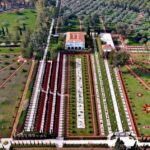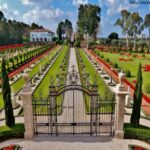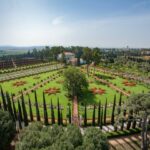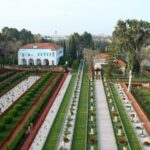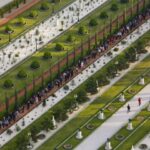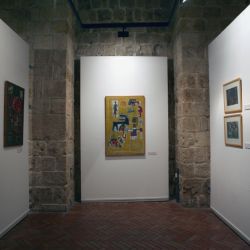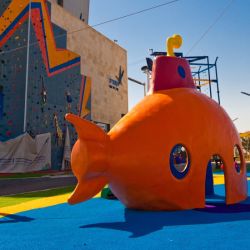Stroll through the magical gardens and soak in the harmony of nature.
The Bahji gardens harmoniously combine different western and oriental elements, all integrated and intertwined with the local nature. In parts of the Baha’i Gardens certain elements of the Persian Gardens can be seen, such as flowerbeds in geometric shapes. The gardens allow the visitor to choose between different tour routes.
Bahjí was where Bahá’u’llah, the prophet who founded the Baha’i religion, lived for the last 12 years of his life. It is also where he was buried after his death, hence the sanctity of the site for Baha’i followers the world over.
There are two historical structures at the site: The Manor and the Shrine of Bahá’u’lláh.
The Shrine of Bahá’u’lláh is where the Prophet was buried and hence, the world’s most sacred pilgrimage site for members of the Baha’i faith. Believers all over the world offer up their hearts and faces toward the Shrine of Bahá’u’lláh every day while they say certain prayers and strive to make a pilgrimage to the site at least once in their lifetime. This site was known as Bahjí or el-Bahjí, meaning “place of happiness” even before Bahá’u’llah lived there.
Bahá’u’llah was born in Iran in 1817. He belonged to an esteemed noble family. His father was a minister in the Sheikh of Iran’s court. From an early age, Bahá’u’llah was renowned for his wisdom and knowledge. He was 22 years of age when his father passed away and he was offered the high-ranking position, however Bahá’u’llah had no intention of spending his life managing terrestrial issues. He left the King’s court and ministers behind and instead, spent his time aiding the poor, the oppressed and the ailing of society. He quickly became known as the defender of justice.
Bahá’u’llah’s Doctrine
Bahá’u’llah lived in 19th century Persia, where prejudice and superstition reigned. It is within this environment that he spread a most sophisticated theory whereby God educated the human race through his messengers who revealed God’s will to mankind from one generation to the next. All religions preach the same basic spiritual principles, despite the fact that they are likely to differ in their secondary social theory. Bahá’u’llah pointed out the fact that humanity was entering its longed-for age of maturity when its full potential would be revealed – the unity of the human race.
Clearly this theory was completely contrary to the entrenched opinions and values of his time. The new movement was also persecuted by both religious scholars and by the government. Many of the faith’s first believers were executed in most cruel fashions. Despite Bahá’u’llah’s noble lineage, he also suffered in the process. He was thrown into a dark dungeon in Teheran called “the black pit”. The fetters around his neck were so heavy that he was unable to lift his head. He spent 4 months there in severe hardship. After he was released from prison, he was banished from Persia along with his family. In the midst of the cruel cold of winter, they crossed the western hills of Iran toward Bagdad, which was then a city in the Ottoman Empire. Over the course of the next ten years, Bahá’u’llah was banished to other cities in the Ottoman Empire until finally in 1868, he was banished to the Holy Land, along with the members of his family and a small group of believers. They were all imprisoned in Akko’s prison citadel.
Despite the fact that at first they were known as a group of daunting heretic prisoners, the Baha’is were eventually treated as a respectable religious community, especially in the wake of the growing recognition of Bahá’u’llah’s greatness and wisdom.
The terms of imprisonment gradually became more flexible, Bahá’u’llah and his family were allowed to live at home within the walls of the City of Akko and later, even to leave the city and live here in the Bahjí mansion. Bahá’u’llah died at the age of 75.
The Bahjí Mansion
The Bahjí Mansion covers an area of over 740 square meters. The second floor was built around 1870 as a summer palace for Údi Khammár, a prosperous Akko merchant, above the former one-story structure that was built many years before in 1821. The owners fled Akko during an epidemic in 1879 and Abdu’l-Bahá first rented and then purchased the mansion for Bahá’u’llah and the Baha’i holy family to live in.
The ground floor is surrounded by columns which had operational and storage purposes. The upper floor is built around a large inner area over which there is a skylight that lets the sunlight into the building. This area is surrounded by large variously sized residential rooms looking out on a balcony. The paintings above the windows on the external walls were selected by Údi Khammár and are considered to be splendid examples of the blend between east and west in Akko. The stained-glass panel was typical of the period and allowed the women of the house to sit on the balcony and maintain their privacy.
The gardens
The aim of the gardens is to provide appropriate access to the Shrine of Bahá’u’lláh, which is the focus of the entire site. In fact, all of these radial paths lead toward the center. The gardens enable the visitor to choose between different paths, some of which surround the Shrine of Bahá’u’lláh. Initial access to the historical structures begins through unofficial gardens, before the entrance to the official, terraced gardens, which lead to the Shrine.
The gardens were designed and are maintained with an emphasis on environmental conservation. Where water utilization is concerned, most of the grass here is seasonal; the irrigation system was designed for effective use; drought tolerant plants, shrubs and trees were selected for the unofficial section of the gardens.
The Bahjí gardens boast a harmonious blend of different western and eastern elements. Certain sections of the gardens feature elements typical of Persian gardens such as geometrically shaped flower beds whereas other sections give prominence to European elements such as marble columns and decorative urns. All of these elements are interlaced within the local nature, e.g. the olive, citrus and pomegranate trees.
The funds for maintaining the structures and the gardens stem solely from Baha’i donations and admission to visitors is free of charge.

